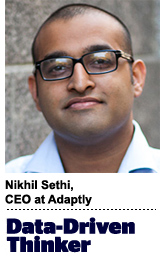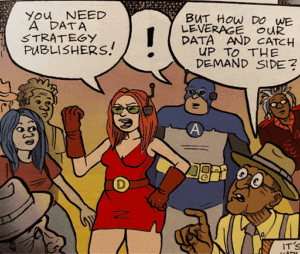 “Data-Driven Thinking” is written by members of the media community and contains fresh ideas on the digital revolution in media.
“Data-Driven Thinking” is written by members of the media community and contains fresh ideas on the digital revolution in media.
Today’s column is written by Nikhil Sethi, CEO at Adaptly.
What is social and what isn’t?
Ultimately, when we say “social,” we refer to platforms with an associated network of people that allows for ideas to flow and spread quickly. These networks have evolved past communicating with friends or family. We now have platforms that use networks of people to play games, determine which local places to visit and raise money for projects that could change the world, among others.
Under these definitions, it becomes increasingly difficult to differentiate between individual platforms. This complicates overall marketing strategies when the term “social” doesn’t fully reflect consumer behavior across all platforms.
Over the course of the past decade of Internet-based advertising, we have produced various vertical channels defined with clear terms, such as display, search, mobile and video. This categorization has allowed for material impact in how brands perceive each channel and their ability to better allocate budgets and create successful models.
Historically, search provided the advertising ecosystem with a monopoly platform to work with (Google), and on the other end of the spectrum, display provided us with immense long-tail fragmentation, requiring consolidation by way of networks, exchanges, DSPs.
A Multiplatform World
This new era of platforms in which we are attempting to categorize falls somewhere in the middle. We know we don’t live in a one-platform world. At the same time, our fragmentation is finite.
At first glance it seems trivial to include social as an additional vertical channel. But diving one layer deeper into some of the major marketing platforms that have become synonymous with social starts to paint a different picture.
Even simply looking at just Facebook and Twitter illustrates two platforms powered by networks of people which are highly visual, operate increasingly in mobile, contain billions of hours of video content, have real-time search capabilities, and as such, encompass and can execute marketing strategies that operate horizontally across all these once defined vertical channels.
AdExchanger Daily
Get our editors’ roundup delivered to your inbox every weekday.
Daily Roundup
This creates quite the categorization and simplification problem. In the case of social, we have such a problem in that each particular platform operates on a unique level by satisfying a brand’s strategy by placing messaging on one such platform, sweeping the value underneath the table by the vernacular we use.
‘Social’ Nuances
Think about yourself as a consumer. Do you consume media the same way on Facebook as you do on Twitter? Each of these environments presents a very unique consumer experience around how to communicate with friends, family and businesses, therefore creating a fundamentally unique consumer behavior. Now add Pinterest, Snapchat, Tumblr, Instagram or Foursquare to the mix. Why should we commonalize all these platforms as “social” when the underlying behaviors are so different?
Because this new layer of platforms is finite in nature, the obvious suggestion is to break down the word and categorization of social into its parts and treat each individual piece as a unique source of consumer attention and, ultimately, a unique opportunity for a brand to create identity and invest strategy.
This may seem like an exponential amount of additional work, but knowing how each environment varies, we can’t continue using social as a catch-all marketing term. It should allow for increased diligence in making experiences resonate, connecting people with the brands they care about and allowing marketers to optimize their presence inside this second layer of global platforms.
Over time, there will definitely be new platforms to emerge, creating new and wholly unique consumer experiences and these platforms will end up thinking about monetization in a highly native and reflective manner. We need new definitions across these new nonconformist platforms that will allow brands and agencies alike to digest and utilize each platform to the fullest extent. In the short term, we need to treat each environment independently.
Follow Nikhil Sethi (@nsethi), Adaptly (@adaptly) and AdExchanger (@adexchanger) on Twitter.












